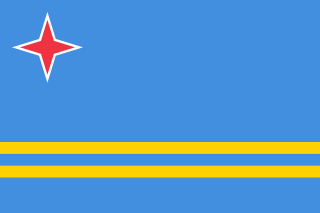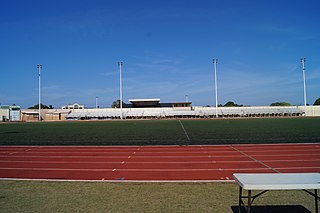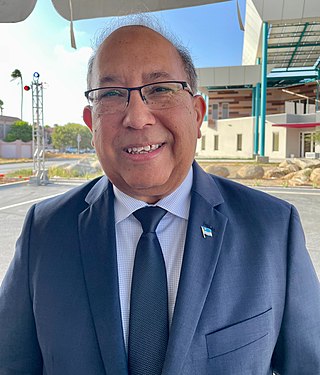
Aruba, officially the Country of Aruba, is a constituent island country within the Kingdom of the Netherlands, in the southern Caribbean Sea 29 kilometres (18 mi) north of the Venezuelan peninsula of Paraguaná and 80 kilometres (50 mi) northwest of Curaçao on the South-American continent. In 1986, Aruba became a constituent country within the Kingdom of the Netherlands and acquired the formal name the Country of Aruba.

The little owl, also known as the owl of Athena or owl of Minerva, is a bird that inhabits much of the temperate and warmer parts of Europe, the Palearctic east to Korea, and North Africa. It was introduced into Britain at the end of the 19th century and into the South Island of New Zealand in the early 20th century.

The geography of Aruba, located at the juncture of the South American and Caribbean tectonic plates, has been shaped by a complex interplay of geological processes. From its flat expanses to its rugged coastlines, Aruba's geography and geology reveal the island's geographical diversity and its underlying geological formations, offering a comprehensive understanding of Aruba's terrain and environmental dynamics of this Caribbean destination.

The northern rough-winged swallow is a small, migratory swallow. It is very similar to the southern rough-winged swallow, Stelgidopteryx ruficollis.

The burrowing owl, also called the shoco, is a small, long-legged, primarily terrestrial—though not flightless—species of owl native to the open landscapes of North and South America. They are typically found in grasslands, rangelands, agricultural areas, deserts, or any other open, dry area with low vegetation. They nest and roost in burrows, and, despite their common name, do not construct these dwellings themselves, rather repurposing disused burrows or tunnels previously excavated and inhabited by other species, such as American badgers, foxes, ground squirrels or prairie dogs, among others.

The spotted owlet is a small owl which breeds in tropical Asia from North Pakistan to Southeast Asia. A common resident of open habitats including farmland and human habitation, it has adapted to living in cities. They roost in small groups in the hollows of trees or in cavities in rocks and buildings. It nests in a hole in a tree or building, laying 3–5 eggs. The species shows great variation including clinal variation in size and forms a superspecies with the very similar little owl.

Guillermo Prospero Trinidad Stadium, is a multi-purpose stadium in Oranjestad, Aruba. It is Aruba's national football stadium, named after Guillermo Trinidad, a politician from the same neighbourhood (Dakota).

A bird nest is the spot in which a bird lays and incubates its eggs and raises its young. Although the term popularly refers to a specific structure made by the bird itself—such as the grassy cup nest of the American robin or Eurasian blackbird, or the elaborately woven hanging nest of the Montezuma oropendola or the village weaver—that is too restrictive a definition. For some species, a nest is simply a shallow depression made in sand; for others, it is the knot-hole left by a broken branch, a burrow dug into the ground, a chamber drilled into a tree, an enormous rotting pile of vegetation and earth, a shelf made of dried saliva or a mud dome with an entrance tunnel. The smallest bird nests are those of some hummingbirds, tiny cups which can be a mere 2 cm (0.8 in) across and 2–3 cm (0.8–1.2 in) high. At the other extreme, some nest mounds built by the dusky scrubfowl measure more than 11 m (36 ft) in diameter and stand nearly 5 m (16 ft) tall. The study of birds' nests is known as caliology.

Shoreline at Mountain View is a park in Mountain View, California, United States. The city park was dedicated in 1983, some fifteen years after the City undertook the daunting task of planning a regional park that would provide citizens with environmentally savvy recreation opportunities, from a site that was originally a landfill.

The Netherlands Antillean guilder is the currency of Curaçao and Sint Maarten, which until 2010 formed the Netherlands Antilles along with Bonaire, Saba, and Sint Eustatius. It is subdivided into 100 cents. The guilder was replaced on 1 January 2011 on the islands of Bonaire, Saba and Sint Eustatius by the United States dollar.
The florin or Aruban guilder is the currency of Aruba. It is subdivided into 100 cents. The florin was introduced in 1986, replacing the Netherlands Antillean guilder at par. The Aruba currency exchange rate for U.S. dollars is Afl. 1.77 for cash and Afl. 1.78 for traveller's checks. Most supermarkets and gas stations use the exchange rate of Afl. 1.75, while many restaurants and shops use the exchange rate of Afl. 1.80.

Arikok National Park, covering 7,907 acres (32 km2) in the northeastern region of Aruba, was officially established in 2000. Approximately 20% of Aruba's total land area is designated as a National Park, dedicated to safeguarding the park's biodiversity, geological formations and historical and cultural significance.

Padú del Caribe was an Aruban musician and songwriter who had been recording and composing for several decades. He wrote "Aruba Dushi Tera", a waltz that is now the national anthem for Aruba and was long a rallying cry for separation from the Netherlands Antilles, which was achieved in 1986.
Antonito Gordiano "Mito" Croes was an Aruban politician of the Aruban People's Party. He served as Minister Plenipotentiary of Aruba from 1994 to 2001. He previously served as member of the Estates and government minister of the Netherlands Antilles and Aruba.

Evelyna Christina "Evelyn" Wever-Croes is an Aruban politician and current Prime Minister of Aruba, serving since November 2017. She is the first woman to hold this office. She is a member of the People's Electoral Movement (MEP) and has been the leader of the party since 2011.
Guillfred Francis Besaril is an Aruban politician of the People's Electoral Movement. He was Minister Plenipotentiary of Aruba between 20 November 2017 and 10 June 2022. He previously served in the Estates of Aruba between 2013 and November 2017, the last month as president.
Jeanette Semeleer is an Aruban economist who has been the president of the Central Bank of Aruba since 2008.

Spaans Lagoen, which translates to "Spanish lagoon", is a coastal bay and wetland area of Aruba. Designated as a Ramsar site since 1980, and in February 2017, it was included within the boundary of the Arikok National Park. It is the only inner bay of Aruba and was formed during the last ice age. This ecosystem features tidal mudflats and mangrove swamps, serving as a vital feeding and breeding ground for birds. Spaans Lagoen is one of the highest biodiversity areas on Aruba. It is also adjacent to Arikok National Park.
The first Wever-Croes cabinet was the cabinet of Aruba from 17 November 2017 to 20 September 2021. It was formed by a coalition government of the political parties People's Electoral Movement (MEP), Proud and Respected People (POR) and Democratic Network (RED), and was led by Prime Minister Evelyn Wever-Croes. It was the country's first coalition government in sixteen years and the first cabinet to be headed by a woman.

Juan Edberto"Ady"Thijsen is an Aruban politician. He has served as Minister Plenipotentiary of Aruba since 2022 and Permanent Representative of Aruba to the European Union since December 2021. He had been Deputy Minister Plenipotentiary from 2021. Thijsen was member of the Parliament of Aruba for the People's Electoral Movement between 2005 and 2021, and served as its President between 2017 and 2021.

















